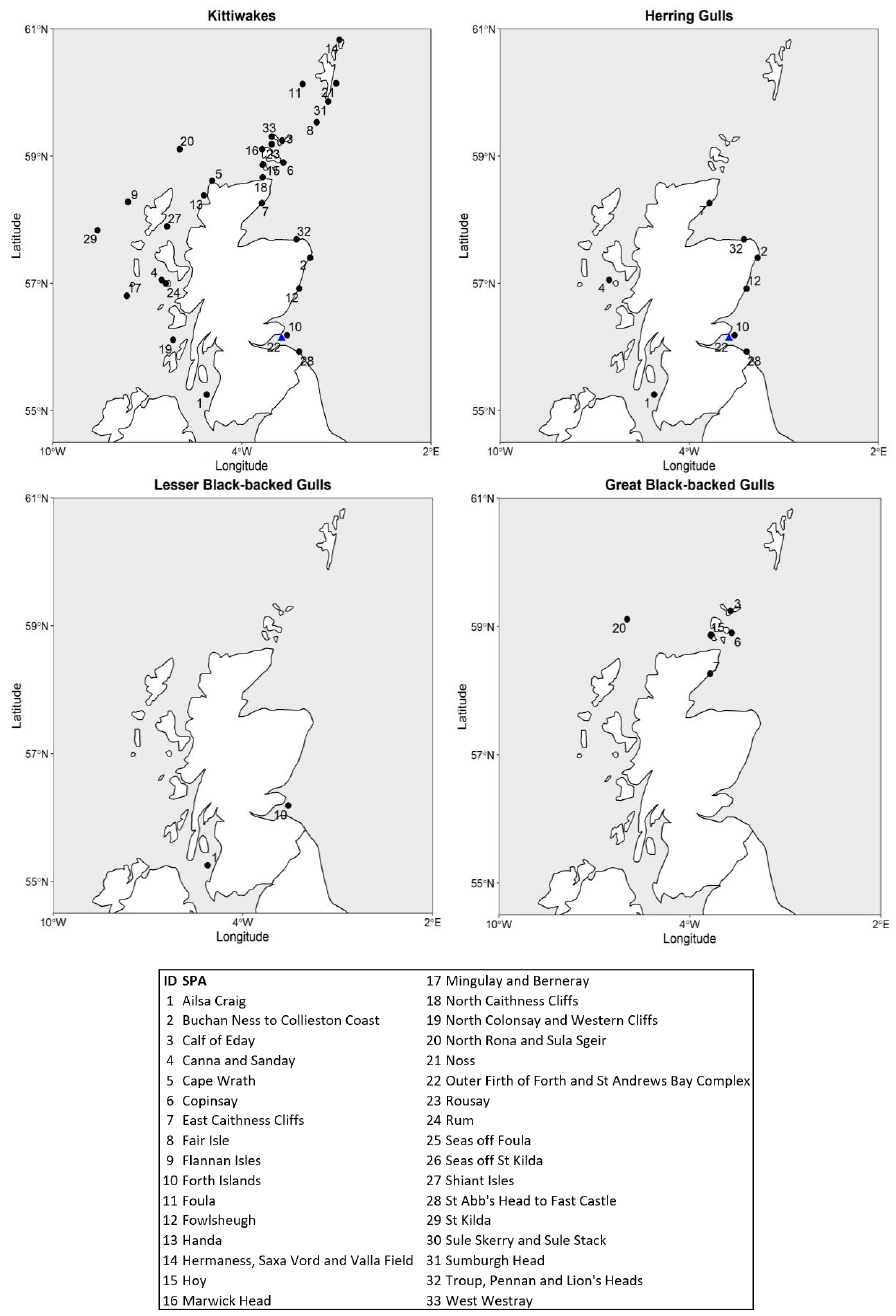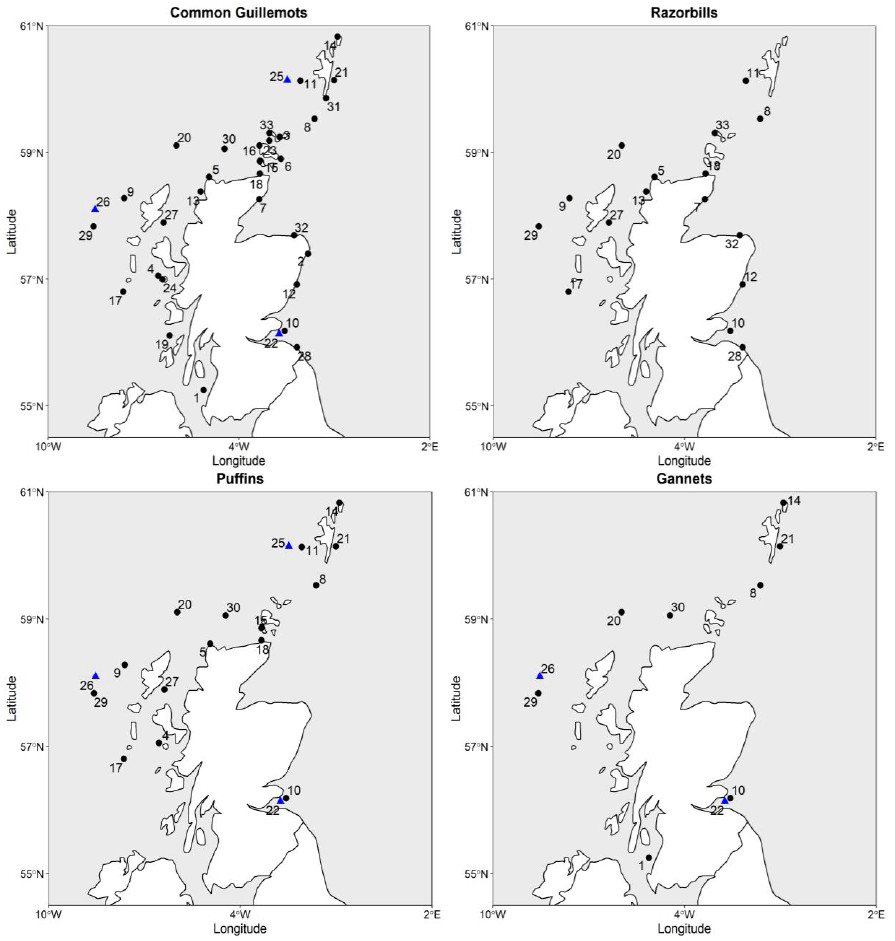Seabirds: strategic ornithological compensatory measures: review
A review of potential strategic ornithological compensatory measures, assessing their practical and ecological feasibility in the Scottish context
12 Appendices
Appendix 1: Table A 1 – Compensatory measures table with potential conservation actions identified
Table A 1. Measures table (following Table 4) with potential conservation actions identified, key points from discussion with steering group summarised, and outcome stated (see Table 6 for details of the reviews identified). Difficulty allocating measure to actions is scored from 1 to 5; 1 = measure corresponds to conservation action, 5 = measure and/or associated actions are unclear.
This table can be viewed in Excel format.
*The initial measures table (Table 4) was discussed at the 1st project steering group meeting held on 20th March 2023. The focus of the discussion was largely restricted to the interpretation of each measure and how these should be considered in the project rather than e.g. inclusion of any additional measures or change in focal species that had been decided prior to the project.
Appendix 2: Description of the different type of reviews considered within the project
Systematic reviews aim to provide an objective and valid summary of primary research findings by following a fully documented and pre-planned procedure that is repeatable (Kugley et al., 2016; Foo et al., 2021). As such, systematic reviews are generally considered to be the most rigorous form of review. A systematic review typically follows the following sequential steps (Kugley et al., 2016; Foo et al., 2021; Higgins et al., 2022): identifying and defining the research questions and associated keywords; conducting the search using database search engines (e.g. Web of Science); screening retrieved literature against a set of inclusion criteria; extracting data from the studies; then finally analysing the data extracted to summarise across all studies. A variant on systematic reviews are meta-analysis studies, which are a more quantitative or statistical approach to collating and summarising the results across studies.
Scoping reviews have a broader more exploratory purpose than systematic reviews. They are generally used to broadly characterise the available evidence and to use that evidence to clarify definitions, understand what type of research has been conducted, and understand knowledge gaps around a topic (Munn et al., 2018). A scoping review can be used as a precursor to a systematic review to inform the questions to be addressed by the review and whether a systematic review may be useful to address these (i.e. whether a systematic review is likely to find sufficient suitable evidence). Researchers are using scoping reviews increasingly, and as a result, there has been development towards their standardisation (Pham et al., 2014; Tricco et al., 2016).
A targeted review is essentially a special case of a scoping review, where there are one or more existing recent detailed reviews for a topic. In this case it does not make sense to duplicate those by undertaking a new review. Instead, a targeted review seeks to summarise the findings of those existing reviews and put the findings in the relevant context (i.e. here strategic compensation) and where further relevant studies or reports have since come available, update the findings.
In addition to a review-based methodology there are alternative approaches to summarising information and reaching conclusions from these. The main alternative approaches are variants on using expert opinion, where instead of using primarily published information, the informed opinions of experts in an area are summarised (in this case this would generally be research scientists [academic and non-academic] and conservation practitioners). This can be achieved in a very structured way using an expert elicitation methodology (Martin et al., 2012) or using a looser methodology with interviews or an opinion piece informed by the existing knowledge of one or more expert authors and a non-systematic use of published literature. Approaches based on expert opinion are most useful where there is a need to rapidly produce informed but preliminary (given that they don’t directly use evidence) conclusions on a topic, or where it is not possible to wait for sufficient evidence to be collected (i.e. by new research studies) to use a more structured review approach. This was the approach used outwith this project to identify candidate compensatory measures (Table 4).
The aim of WP1 was to assess the ecological feasibility of the proposed compensatory measures. While any of the above approaches could have been taken, a systematic review was the approach most likely to reach clear, unbiased, and unambiguous outcomes on ecological feasibility. However, a systematic review is only possible where there is a clearly defined and specific question to address and will only reach a clear outcome where sufficient evidence exists. In the context of this project, this requires that one or a small number of specific conservation actions are first identified such that a small number of research questions are defined. For some compensatory measures it may have been possible to use a meta-analysis approach, however this is a more time-consuming approach and was not possible to do within the timescale of this project.
For those compensatory measures where it was not possible to reach a short list of specific conservation actions, a scoping review was conducted. The scoping review was used to identify a candidate list of conservation actions corresponding to each compensatory measure, deliver judgement on which of these conservation actions are most likely to be ecologically feasible, and provide recommendations around further evidence needs. However, it was not possible to reach firm conclusions on the ecological feasibility of these compensatory measures as subsequent systematic review on the identified conservation actions would be required. It was therefore not possible to take these compensatory measures forward to WP2, the practical feasibility component.
In one case we used a targeted review approach (see Bycatch mitigation in longline fisheries), which is a similar approach to a scoping review but drawing on a smaller range of literature. We used this approach where recent highly relevant reviews already existed, thus it did not make sense to replicate these. Instead, we summarised and set out the findings of the existing reviews in the context of strategic compensation (which the existing reviews did not consider) and, where relevant, supplemented these with findings from other literature. The purpose here was to determine whether the associated conservation actions would be ecologically effective – but this was not scored quantitatively in the same way as with the systematic reviews.
Appendix 3: Table A 2 – List of inclusion/exclusion criteria used during screening in systematic literature reviews at the title and abstract level and full-text level
Table A 2. List of inclusion and exclusion criteria during screening in systematic literature reviews
at the title and abstract level and full-text level.
This table can be viewed in Excel format.
Appendix 4: Figure A 1 – Location of Scottish breeding SPAs of each focal species


Appendix 5: Table A 3 – Key findings of studies for each seabird species and seabird species group for mammalian predator eradication and/or management review
Table A 3. Key findings and details of the studies for each seabird species and group of seabird species for the mammalian predator eradication and management review. Focal species are in italics. Information regarding boobies, frigatebirds, noddies, and tropicbirds were excluded as it was deemed less relevant. Colour coded by effect; red = no effect, yellow = small effect but not enough for population increase (e.g. populations stabilised, recolonizations but no evidence of breeding, decreased rate of decline), blue = effect that can lead to an increase in the population (e.g. measured increase in productivity).
This table can be viewed in Excel format.
Contact
Email: ScotMER@gov.scot
There is a problem
Thanks for your feedback